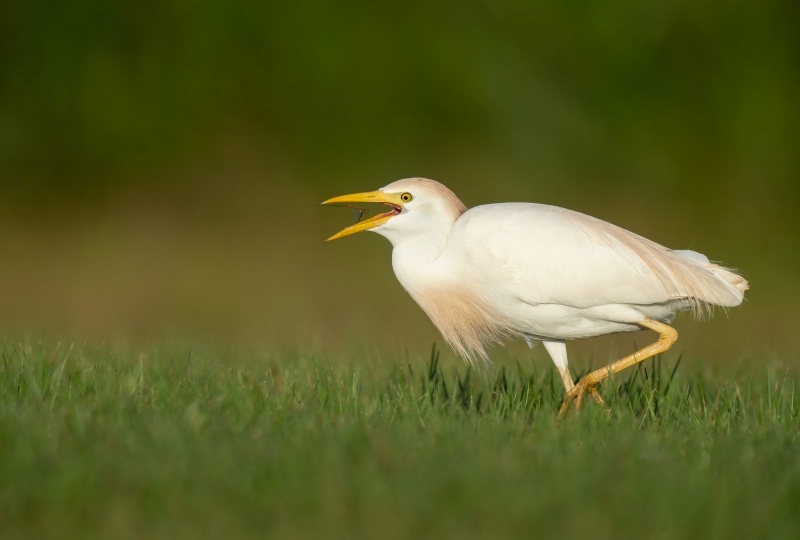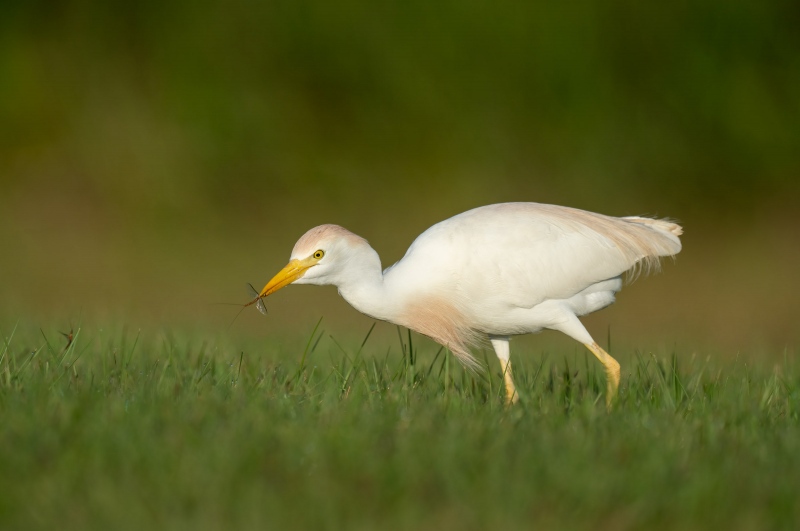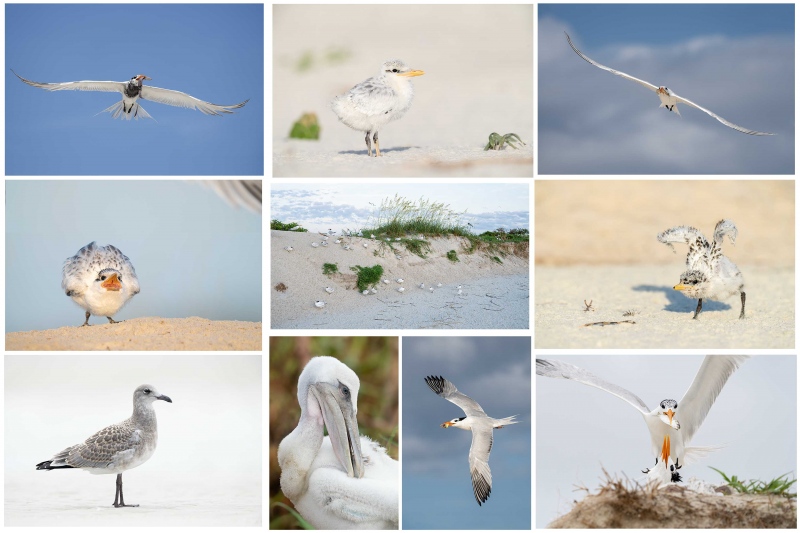What’s Up?
Monday morning down by the lake was quite interesting. Several of the Osprey nests are overflowing with three large chicks. I tried to photograph at the best one and failed. The newest crane baby is already about half as large as its parent. For the past few days, I have not seen one of the two parent birds with the two large colts. I did see the eagle family flying around together for the first time. And a pair of Black-necked Stilts showed up just to the left of the pier.
There was a big hatch of the large mayflies overnight. I was surprised that only a single Cattle Egret was partaking of the feast. It was soon joined by the large crane colt family of three. I shot the whole gang. On what seemed like a slow morning for photography I created more than 1700 images. Why? I was trying to get head portraits of the crane colts with a mayfly in their bill at 1200mm and was taking full advantage of the 30 frames/second frame rate of the Sony a1. Then I got out of my SUV and tried the same with the hand held 200-600. Last was a Great Blue Heron standing on a dock at 1200mm.
The feeding Sandhill Cranes were moving quickly in all directions and as a result, about 90% of the images were badly mis-framed. I have no idea if I got even a single keeper … But you can’t win if you don’t play!
Today is Tuesday 10 May. As of Monday evening, I was not sure if I was going to Stick Marsh or down to the lake on Tuesday morning … Wherever you are and whatever you are doing, I hope that you too have a great day. This blog post took about an hour to prepare and makes sixty days in a row with a new one.
Please remember to use the B&H and Amazon links that are found on most blog pages and to use the BIRDSASART discount code at checkout when purchasing your new gear from Bedfords. Please, also, consider joining a BAA IPT. You will be amazed at how much you will learn!
This Just In!
I kept 61 of 1703 images from Monday morning. If you are counting, that is a keeper rate of only .0358, less than 4%. I told you it was difficult. I did get a few decent ones of a crane with a mayfly, but the Cattle Egret images were far stronger. The two best of those with a mayfly are featured in today’s blog. In addition, I kept 18 vertical images of the Cattle Egret ruffling.
Your Favorite?
Which of today’s two very excellent images do you like best. I think that that is a tough call. If you leave a comment, please be sure to let us know why you made your choice.
Selling Your Used Photo Gear Through BIRDS AS ART
Selling your used (or like-new) photo gear through the BAA Blog is a great idea. We charge only a 5% commission on items priced at $1,000 or more. With items less than $1000, there is a $50 flat-fee. One of the more popular used gear for sale sites charged a minimum of 20%. Plus assorted fees! Yikes. They went out of business. And e-Bay fees are now up to 13%. If you are interested, please click here, read everything carefully, and do what it says. To avoid any misunderstandings, please read the whole thing very carefully. If you agree to the terms, please state so clearly via e-mail and include the template or templates, one for each item you wish to sell. Then we can work together to get your stuff priced and listed.
Stuff that is priced fairly — I offer pricing advice only to those who agree to the terms — usually sells in no time flat. Over the past years, we have sold many hundreds of items. Do know that prices for used gear only go in one direction. Down. You can always see the current listings by clicking here or on the Used Photo Gear tab on the orange-yellow menu bar near the top of each blog post page.
New Listings
Canon EF 100-400mm f/4.5-5.6L IS II USM Lens with great extras!
Ted Keltz is offering a Canon EF 100-400mm f/4.5-5.6L IS II USM lens (with extras) in excellent condition for $1488.00. The sale includes the rear lens cap, the front lens cap, the lens hood, the tough fabric ens case, the original product box and manual, a LensCoat, a Canon Extender EF 1.4x II in like new-condition $429.00 new), a Canon 25 mm Extension Tube EF 25mm II in like new-condition ($144.95 new), and insured ground shipping via major courier to lower-48 US addresses only. (Both accessories include the front and rear lens caps and the lens pouches.) Your item will not ship until your check clears unless other arrangements are made.
Please contact Ted via e-mail.
This incredibly versatile zoom lens — with its amazing .98 meter close focus — was my favorite Canon telephoto zoom lens ever. By far. It is easy to hand hold, great for tight portraits, for birds in flight, for quasi-macro stuff, and lots more. For flight, it is fabulous with an R5! This package sells new of $2972.95 so you can save an amazing $1584.95 by grabbing Ted’s lens with the great extras now. artie
Canon Extender EF 2X III
Sale Pending first day of listing
Ted Keltz is offering a is offering a Canon Extender EF 2X III (teleconverter) in like-new condition for $259.00. The sale includes the front and rear caps, the soft case, the original product box, and insured ground shipping via major courier to lower-48 US addresses only. Your item will not ship until your check clears unless other arrangements are made.
Please contact Ted via e-mail.
As regular readers know, TCs are so important to what I do that I always travel with three 1.4X teleconverters and two 2X teleconverters. (Note: they do fail on occasion …) The 2X III sells new for $429.00. artie
|
|
|
This image was created on 9 May 2022 on the South Peninsula down by the lake near my home at Indian Lake Estates. Working from the front seat of my SUV, I used the BLUBB-supported Sony FE 600mm f/4 GM OSS lens, the Sony FE 2.0x Teleconverter, and The One, the Sony Alpha 1 Mirrorless Digital Camera). The exposure was determined via Zebras technology with ISO on the Thumb Dial. ISO 800: 1/1600 sec. at f/8 (wide open) in Manual mode. The exposure was dead solid perfect when evaluated in RawDigger. AWB at 7:43:46am on a sunny morning. Tracking: Upper Left Zone/AF-C with Bird Face/Eye detection enabled performed to perfection. Be sure to click on the image to enjoy a high-res version. Image #1: Cattle Egret ready to swallow mayfly |
Multiple Choice Quiz
Which of the following contributed most to the artistic success of Image #1?
There was a bit of motion blur on the bird’s eye. I painted a Quick Mask of the eye and as expected, Topaz Sharpen AI rendered it much sharper at 80% without making a mess of things.
Great Topaz News!
As regular readers know, I run DeNoise on virtually every image that I process immediately after executing the crop with the Delete Cropped Pixels box checked. For images made in sunny conditions, I used Standard. For images made in low light, I use Low Light. You can check all four methods by using the Comparison View but I rarely do that any more as I am confident as noted above.
Folks who use the BAA Topaz link to purchase Sharpen AI, DeNoise AI, or the Utility Bundle (or any other Topaz plug-ins), will receive a 15% discount by entering the ARTHUR15 code at checkout. If the stuff is on sale (as it usually is), you save 15% off of the sale price! To get the discount you must use my link and you must enter the discount code. Be sure to start with this link.
Those who purchase Sharpen AI, DeNoise AI, or any other Topaz plug-ins using my link and then entering the ARTHUR15 code at checkout can e-mail to request a short Getting Started with Topaz e-Guide. Please include a copy of your Topaz receipt that shows the discount. Aside from the basics, the guide explains how to install the plug-ins so that they appear in the Photoshop Filter Menu.
|
|
|
This image was created on 9 May 2022 on the South Peninsula down by the lake near my home at Indian Lake Estates. Working from the front seat of my SUV, I used the BLUBB-supported Sony FE 600mm f/4 GM OSS lens, the Sony FE 2.0x Teleconverter, and The One, the Sony Alpha 1 Mirrorless Digital Camera). The exposure was determined via Zebras technology with ISO on the Thumb Dial. ISO 800: 1/1600 sec. at f/8 (wide open) in Manual mode. The exposure was dead solid perfect when evaluated in RawDigger. AWB at 7:43:49 am on a sunny morning. Tracking: Upper Left Zone/AF-C with Bird Face/Eye detection enabled performed to perfection. Be sure to click on the image to enjoy a high-res version. Image #2: Cattle Egret holding mayfly in bill tip |
Three Seconds Later
Image #2 was made three seconds after Image #1. It would have made a nice sequence if the order had been reversed, but the background would have been a mismatch as the bird had walked to my left. In both images the sharpness of The Sony rig at 1200mm is astounding. I cannot believe that the mayfly posed so perfectly right before it became breakfast.
|
|
|
Click on the composite image to enjoy the incredible quality of the hi-res JPEG. Clockwise from upper left clockwise and back around to the center: Royal Tern in flight with squid for chick; Royal Tern chick on beach; Royal Tern in flight with shrimp for young; Royal Tern chick — double overhead wing stretch; Royal Tern landing with greenback for chick; Royal Tern in flight with juvenile mahi mahi for chick; Brown Pelican — large chick preening; Laughing Gull in fresh juvenal plumage; Royal Tern chick begging; Many Royal Terns with many chicks on face of dune. |
Jacksonville IPT: #1: 4 FULL DAYS — the afternoon of 16 June thru the morning of MON 20 June 2022: $2,099.00. (Limit 6 photographers)
Jacksonville IPT #2: the afternoon of FRI 1 JULY thru the morning of TUES 5 July 2022: $2099.00 (Limit 6 photographers)
Jacksonville IPT #3: the afternoon of FRI 15 JULY thru the morning of TUES 19 July 2022: $2099.00 (Limit 6 photographers)
Ride with me: add $200.00. I do not like to disappoint: each trip will run with one participant. If necessary.
I first visited the breeding bird colony at Jacksonville in late June 2021. I was astounded. There were many thousands of pairs of Royal Terns nesting along with about 10,000 pairs of Laughing Gulls. In addition to the royals, there were some Sandwich Terns nesting. And there are several dozen pairs of Brown Pelicans nesting on the ground. Flight photography was non-stop astounding. And photographing the tern chicks was relatively easy. Folks could do the whole trip with the Sony 200-600, the Canon 100-500 RF, or the Nikon 500 PF or 200-500 VR. With a TC in your pocket for use on sunny days. Most of the action is within 100 yards of where we park (on the beach). As with all bird photography, there are times when a super-telephoto lens with either TC is the best tool for the job.
Morning sessions will average about three hours, afternoon sessions about 1 1/2 hours. On cloudy mornings with favorable winds, we may opt to stay out for one long session and skip the afternoon, especially when the afternoon forecast is poor. Lunch is included on the first three days of the IPT and will be served at my AirBnB. After the first lunch there will be an introductory program. On days two and three we will do image review and Photoshop after lunch.
We will be based somewhere west and a bit north of Jacksonville where there are many AirBnB possibilities. The deposit is $599.00. Call Jim at the office any weekday at 863-692-0906 to pay by credit card. Balances must be paid by check.
What You Will Learn on a Jacksonville IPT
- 1- First and foremast you will learn to become a better flight photographer. Much better.
- 2-You will learn the basics and fine points of digital exposure. Nikon and Canon folks will learn to get the right exposure every time after making a single test exposure, and SONY folks will learn to use Zebras so that they can be sure of making excellent exposures before pressing the shutter button.
- 3- You will learn to work in Manual exposure mode even if you fear it.
- 4- You will learn to evaluate wind and sky conditions and understand how they affect bird photography, especially the photography of birds in flight.
- 5- You will learn several pro secrets (for each system) that will help you to become a better flight photographer.
- 6- You will learn to zoom out in advance (because the birds are so close!) 🙂
- 7- You will learn how to approach free and wild birds without disturbing them.
- 8- You will learn to spot the good and the great situations.
- 9- You will learn to understand and predict bird behavior.
- 10- You will learn to design pleasing images by mastering your camera’s AF system.
- 11- You will learn to choose the best perspective.
- 12- You will learn to see and control your backgrounds.
- 13- You will learn to see and understand the light.
- 14- You will learn to see and create pleasing blurs in pre-dawn situations.
- 15- You will learn to be ready for the most likely event.
And the best news is that you will be able to take everything you learn home with you so that you will be a better photographer wherever you are and whenever you photograph.
Typos
With all blog posts, feel free to e-mail or to leave a comment regarding any typos or errors.

















Hey Artie, really like both but I think the Mayfly perfectly positioned in the second take it over the top. I like how the green of the grass and background make the Cattle Egret stand out.
Lack of sharpness in both images; their feathers have no detail, a monitor issue? Processing? File size, too big for the number of pixels. Umm…
Hi Bruce, Thanks for dropping by to comment. Are you looking at the high-res versions? Both images are razor-sharp. There is plenty of detail in most of the white feathers. In soft light, the brightest white feathers will simply not show much detail.
In short, I am not sure what you are looking if there is a monitor problem on your end.
with love, artie
I enjoyed both images. Splitting hairs to choose between them. Two comments:
1. I experienced this same issue in my recent FL trip. Shooting birds on an obviously mowed field creates an artificiality in the environmental context that I find unfortunate. It is not a major negative, just an annoyance that distracts me. Not much you can do about it – perhaps you are habituated to it it since you find birds on those fields so often.
2. I agree with Maggi about the lower o-o-f foreground. I think it is the yellows at the very bottom, mostly on the left that bugged me. I did a virtual crop by opening the images in a separate browser and then sliding the browser down until a bit of the image was obscured at the bottom. I found that “cropping” only about 20 % of the way up to the bird’s visible legs did the trick for me – and it still leaves the virtual feet and much of the layering that you like. Try it.
Hey Bruce, Thanks for commenting. The mowed fields do not bother me at all. The birds love them. I still like the o-o-f foreground grasses but am fine that you and Maggi do not like them. Furthermore, the image would be top-heavy with any crop from the bottom.
with love, artie
Both great images Artie, with the slightest preference for Image 2… just the angle of the bird maybe? However, and I know you will not agree, the great expanse of blurred grass at the bottom of both images is a distraction & does my eyes in! I would have liked to see more of the actual grass rather than a blur, even if it was semi-blurred.
I’d personally lop a good half inch off the bottom, where it’s darker and crop accordingly. But that’s just my preference & what do I know? Plus, I do have an eye infection at the moment!
Thanks, Maggi. I actually like the dark o-o-f grass in the foreground. It gives the images a layered effect. In addition, I would not want to cut the virtual feet. But what the heck do I know? Get better soon.
with love, artie
Both are great (love the soft green background) but my favorite is the one with the open mouth and mayfly inside!
Thanks a stack, Pat.
with love, artie